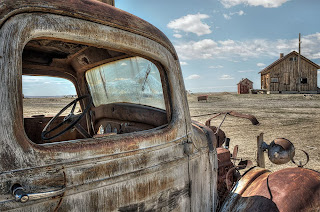 |
| Final HDR Image (c) Sandy LeBrun-Evans |
Most photographers have an immediate reaction to HDR photography: they either love it or hate it. MEG member Sandy LeBrun-Evans falls in the "love" camp and explains more about her technique.
Why does HDR photography appeal to you? HDR is an acronym for High Dynamic Range, which means that images are composited to extend the dynamic range beyond what our cameras currently can capture. While our eyes can adjust to an image and see the dynamic range, our cameras cannot, so when there is a wide range between light and dark, no single exposure in a camera can capture all of the lights and all of the darks in a scene. By working in HDR, I am able to produce images that include the entire range between light and dark.
 |
| Bracketed image examples, light to dark |
How do you create an HDR image? To capture all of the lights and darks in a scene, I take anywhere from 3 to 12+ exposures of a single scene. If the scene doesn't have an extreme dynamic range, I set my camera on AV and set bracketing on my Nikon D700 to bracket from 3 to 9 shots (whatever it takes to obtain all of the lights and all of the darks) and shoot. If the dynamic range is extreme, I set my camera to the manual mode and manual focus, bracket by shutter speed, and take as many images as I think I'll need.
 | |
| Composite .tiff file ready for final processing |
I am always on a tripod and I turn off VR (Vibration Reduction) on my lens as VR can cause movement during the capture process. I then blend as many images as required to cover the full dynamic range in Photomatix software and save the processed image as a .tiff file. Finally, I take the .tiff file into Photoshop (I'm currently working in PS6) and finish the print as I desire for my final print.
Do you always shoot for HDR or do you only do so for specific images? I usually always bracket when shooting just in case I think I might need to process my image as an HDR image. You can always spot me — or I should say hear me — because I am the one making that annoying CLICK, CLICK, CLICK... as I capture those 3 to 9 images.






No comments:
Post a Comment